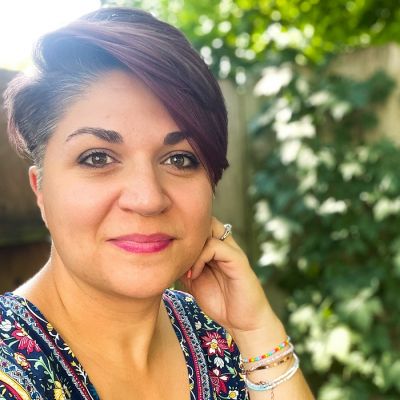
Jayme Hayes
Mayberry Cultural and Fine Arts
Magnet Middle School
Wichita, Kansas
When the world went into lockdown because of the COVID-19 pandemic, Jayme Hayes tackled online learning with gusto. “I became a content-creating maniac,” she said. “Resources like method books, online theory tools, even YouTube instructional videos were not made for 100% online teaching, and that was the biggest problem I faced at first. I realized I needed to create content that matched my program and me as a teacher. I created practice and assessment tools with Boom Cards, YouTube and Flipgrid for almost every lesson.”
Much of what Hayes learned, experienced and taught during remote and hybrid teaching has now become a central part of her classroom at Mayberry Cultural and Fine Arts Magnet Middle School. She effectively reaches students at their level of understanding by providing more resources and chances for them to succeed. “I still incorporate online tools like Boom, Flipgrid and YouTube, but they are more spread out throughout the week or quarter,” she says. “We use iPads for composition projects, tuning activities, aural skills activities and listening evaluation. Students are given multiple opportunities to show their level of proficiency as we learn and develop music skills.”
She was so adept at teaching remotely that the Kansas Music Educators Association (KMEA) asked her to speak at its virtual convention. Her presentation focused on how virtual teaching did not have to be any less effective, impactful or educational than in-person teaching. “It was a session about our mindset when it came to teaching online,” Hayes explains. “We were/are still educators who are passionate about our students and music. I refused to allow the screen to remove that from my classroom, and I tried to empower others to do the same. I do not teach music to young people, I teach young people through music. A camera wasn’t going to stop me from doing that.”
How did Hayes find ways for students to make music remotely? “With comic relief mixed in with high expectations, honesty and transparency,” she says.
Each quarter had a theme and everything was planned around that theme. Hayes used poems and children’s books to learn about improvisation, composition, teamwork and performance. “Every day we played with recordings, metronomes, call and response, singing and playing,” she says. “We played interactive games using rhythms and our instruments like charades, Pictionary, Clue and a very creative version of Among Us that I got from the Band Directors Facebook page because there are other teachers who are a lot more creative than me.”
Hayes admits that honesty was the biggest part of the shared creativity with her students. “I told the kids that I was trying my best with these new crazy ideas, and they were eager to try them out,” she says.








